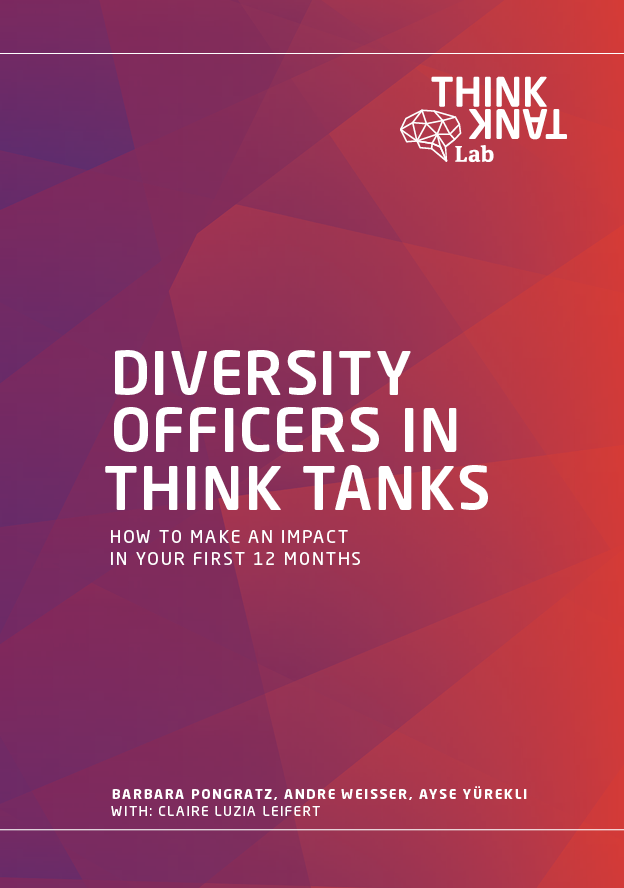To help people coming into a Diversity Officer role, we have developed a blueprint for organizations to follow when creating new DEI positions. It primarily helps a new Diversity Officer plan out their activities and understand where their role may begin and end. We intend it to serve as inspiration for think tank leaders, HR, and any other interested parties in think tanks. The steps below are the product of multiple discussions during the Think Tank Lab Diversity Challenge. Moreover, we had the chance to speak with various individuals, who are already in DEI positions in think tanks or similar organizations (e.g. governmental agencies), who helped us summarize the action points.
We hope it helps organizations bring more structure to their DEI activities and contributes to making think tanks in Germany and beyond more diverse, equitable, and inclusive.
1. BUILD YOUR PERSONAL KNOWLEDGE BASE
Whether you’re a DEI professional, a member of the HR team, or a researcher, expanding your own knowledge is vital. Consider participating in training programs on diversity, equity, and inclusion to grow your understanding of DEI topics in the workplace and browse through the resources at the end of this article. The Gender, Think Tanks & International Affairs Toolkit or the overview by Charta der Vielfalt (in German) are good starting points.
2. DEFINE A STARTING POINT
Candidates coming into a DEI role in a new organization need to think about where to start. When an explicit role is created for a Diversity Officer, they often stand alone in the organization and need to set the course of their own work. The first thing to do is understand the current state of the think tank’s diversity measures. Mapping out and evaluating what already exists will help you see where efforts are strong, weak, or non-existent. Mapping your think tank’s current efforts and initiatives will also help you define which dimensions of diversity need to be addressed most urgently and prioritize your efforts accordingly. This is the baseline from which you can start planning the DEI measures you want to take and which you can use to measure progress.
3. SHARE YOUR KNOWLEDGE INTERNALLY
We know that Diversity Officers push forward DEI initiatives for organizations. But organizations are made up of people. It’s not enough for the Diversity Officer to be the only one making the organization more diverse, equitable, and inclusive. That’s why it’s important to organize internal awareness-raising events and training programs to pass your knowledge on to your colleagues.
4. SET REALISTIC TARGETS AND DEFINE SUCCESS METRICS
The next step is setting realistic, concrete targets, and defining metrics that help monitor progress. It is helpful to get the think tank leadership and colleagues from different departments involved in this process to make sure the targets are realistic and to create ownership for them. Together, agree on metrics that allow you to monitor progress. For example, if you want to achieve equal representation of women and men in policy debates, you can ask the events department to count the number of women and men on your event panels each year, as well as the number of events with only men on the panel.
5. SET UP SUSTAINABLE STRUCTURES AND REPORTING
Set up sustainable processes and structures to monitor progress. This may include communicating reporting obligations for individual teams, setting up formats for regular exchanges of best practices with different departments (such as management and HR), and standardized procedures to involve think tank leadership in DEI work. Don’t forget to report to your team what overall progress has been achieved on the targets defined in the beginning. For example, you could send around an internal Diversity Report in an email comparing the metrics of the current year to those from the baseline year before you started and give recommendations of what to focus on in the upcoming year. Seeing what progress has been achieved will be motivating for everyone involved and seeing where you are behind your targets will create attention for this matter. You can find an excellent starting point for this step on the Diversity Council Australia’s Website “Get Your Baseline D&I Data”.
6. NETWORK WITH YOUR PEERS
Exchanging regularly with people in similar roles in other organizations helps all think tankers working on diversity to improve their work. Comparing experiences and sharing what has worked and what has not, helps the whole think tank industry improve. A good starting point is the #teamDiversity, a network that has sprung up from the Think Tank Lab’s Diversity Challenge. If you wish to join our bi-monthly meetings in Berlin, please contact Andre Weisser from Stiftung Neue Verantwortung via aweisser@stiftung-nv.de. You can find a list of all networks and initiatives on the gender, think-tanks and international affairs dashboard.
7. DEVELOP YOUR ROLE FURTHER
Having followed steps one to six, you will have hopefully created fertile conditions for real change towards more diversity, equity, and inclusion in your organization. Now, you can think about further developing the role of Diversity Officer. Consider starting an internal diversity working group within your organization and share your experiences with others so they can follow your example!
To help you with all of that, we created a list of further resources that you can use to:
-
Inform yourself about existing networks and initiatives in the field of diversity and inclusion.
-
Make yourself familiar with their good practices and toolkits that can be applied directly to your organization.
-
Educate yourself on existing studies and ways to gather your own data as a diversity officer.






